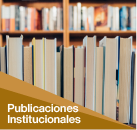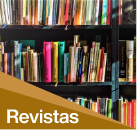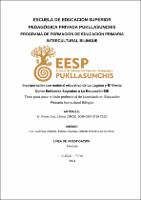Mostrar el registro sencillo del ítem
Incorporación con material educativo de la Laguna y el Viento como Entidades Sagradas a la Educación EIB
| dc.contributor.advisor | Guevara Valdivia, María Graciela | |
| dc.contributor.author | Flores Diaz, Liliana | es_PE |
| dc.date.accessioned | 2025-06-02T03:26:48Z | |
| dc.date.available | 2025-06-02T03:26:48Z | |
| dc.date.issued | 2024-04-24 | |
| dc.identifier.uri | http://repositorio.pukllasunchis.org/xmlui/handle/PUK/127 | |
| dc.description.abstract | Para empezar, para este trabajo de investigación me he enfocado en observar y reflexionar sobre una escuela y su territorio sagrado. Este trabajo tiene como objetivo, estudiar los saberes sobre el territorio que tienen los pobladores de una escuela primaria EIB. Desde ahí, me propuse incorporar y fortalecer la identidad a través del diálogo de los saberes ancestrales y la tradición oral, relacionadas con algunos seres de la cosmovisión andina como son, las lagunas y los vientos. Los vientos y el agua en específico, son entidades muy importantes para la comunidad. Por ello, con esta investigación se pretende rescatar los conocimientos para que sean aplicados en la escuela. Tengo la seguridad de que este trabajo será de gran ayuda para que otros docentes manejen una perspectiva más amplia, para dar a conocer la comprensión cultural que tienen las poblaciones quechuas de la región y la diversidad de conocimientos sobre los ancestros. Lo importante es poner en valor la importancia de los distintos saberes culturales para construir una EIB de calidad. Actualmente, la escuela en pocas oportunidades fortalece estos saberes. Esto motivó mi interés por elaborar un material audiovisual narrativo, que recoja los saberes ancestrales sobre el territorio sagrado, a fin de fortalecer la identidad cultural en niños y niñas de primaria EIB. Se sabe que los saberes ancestrales influyen en la educación de manera constructiva y significativa. El tipo de estudio que se propone es el cualitativo. Recojo testimonios sobre las lagunas y los vientos y a través de la aplicación de una experiencia educativa, observo cómo acogen los niños y niñas, estos conocimientos. Para el recojo de información, la población de referencia fue la comunidad de Anyarate en Cusco. La muestra de aplicación se ubicó en el proyecto educativo “Chico Latino”, organización dedicada a la educación, cuya sede queda en la comunidad de Choquepata, Tipón también en Cusco. Se emplearon como instrumentos: encuestas y entrevistas y la conclusión más importante es que la comunidad educativa debe trabajar de la mano con la escuela, haciendo que las actividades festivas y del diario vivir sean parte de las enseñanzas en el aula y en sus hogares. Así mismo, que los estudiantes tengan esa noción de consolidar su identidad a partir de narraciones orales y de sus historias. | es_PE |
| dc.description.abstract | Abstract To begin with, for this research work I have focused on observing and reflecting on a school and its sacred territory. This work aims to study the knowledge about the territory that the residents of an EIB primary school have. From there, I set out to incorporate and strengthen identity through the dialogue of ancestral knowledge and oral tradition, related to some beings of the Andean worldview such as lagoons and winds. Winds and water specifically are very important entities for the community. Therefore, this research aims to rescue knowledge so that it can be applied in school. I am sure that this work will be of great help for other teachers to manage a broader perspective, to publicize the cultural understanding that the Quechua populations of the region have and the diversity of knowledge about their ancestors. The important thing is to value the importance of different cultural knowledge to build a quality IBE. Currently, school rarely strengthens this knowledge. This motivated my interest in developing narrative audiovisual material that collects ancestral knowledge about the sacred territory, in order to strengthen the cultural identity of EIB primary school boys and girls. It is known that ancestral knowledge influences education in a constructive and significant way. The type of study proposed is qualitative. I collect testimonies about the lagoons and the winds and through the application of an educational experience, I observe how the boys and girls receive this knowledge. For the collection of information, the reference population was the community of Anyarate in Cusco. The application sample was located in the educational project “Chico Latino”, an organization dedicated to education, whose headquarters are in the community of Choquepata, Tipón, also in Cusco. Surveys and interviews were used as instruments and the most important conclusion is that the educational community must work hand in hand with the school, making festive and daily activities part of the teachings in the classroom and in their homes. Likewise, that students have the notion of consolidating their identity based on oral narrations and their stories. Keywords: (Bilingual Intercultural Education, ancestral knowledge, territory, school, sacred entities, lagoon and wind, respect, Andean culture). | es_PE |
| dc.description.abstract | Pisi rimayllapi willasayki Kay yachay maskay llamkayta qallarinaypaqmi qawarirqani hinaspa yuyaymanarqani huk sagrado territoriomanta hinaspa escuelamanta, chaymi kay llamkayqa munan yachaykunata estudiayta territoriomanta huk EIB primaria escuelapi identidadta churanapaq hinaspa kallpanchanapaq rimanakuywan ñawpaq yachaykunamanta hinaspa tradición oralwan tupaqmanta wakin kawsaqkunaman cosmovisión andina lagunakunaman, wayrakunamanpas. Rimanakuspaqa, hatun tayta mamakunapa yachayninta mana waqaychaspa chiqap kasqanmanta, yachaywasi qillqakunapiqa huk yuyayllatam hatarichin territoriomanta, chaymi qawarichin huk uchuy allpa hina sociedadta determinanapaq. Chaynallataqmi, yachakuqkunapi pachantinpi yachaykunata paqarichimun, hinallataqmi kallpanchan ñawpaq taytanchikkunamanta chaskisqa yachaykunata huk lawman churanankupaq. EIB primaria yachaywasipi qhari wawakuna, warmi wawakunapi identidad cultural nisqa kallpachasqa kananpaq.Hay tipo de estudio nisqa ruwayqa investigacin aplicada nisqa ruwanapaqmi, chaymanta enfoque cualitativo nisqa ruwanapaqmi. Willakuy huñunapaq yachaywasi muestraqa hurqusqam karqa pichqa kaq grado primaria I.E. 50354 Cesar Vallejo de Anyarate.Chay proyecto propuesto nisqapa aplicacionninpa ejemplonmi kachkan proyecto educativo Chico Latino nisqapi, chaypa sede centralninqa Choquepata Tipon ayllupim kachkan. Instrumento hinam encuestakuna, testimoniokuna, entrevistakuna, entrevistakuna adaptacion, contexto ima churasqa karqa. Tukuchinapaqqa, kay yachay maskay llamkaymanta aswan allinqa, yachaywasipi, ayllu llaqtawan makipura llamkananku, raymi ruwaykunata, sapa punchaw kawsayta ima, aulapi, wasinkupipas yachachikuykunamanta hukninman tukuchispa, chaynallataqmi yachakuqkunapas chay yuyayniyuq kanku takyachinankupaq identidadninkuqa narrativas orales nisqapi, willakuyninkupi hapipakuspa. Tukuypiqa, ñawpaq yachaykunata mastarikun Educación Intercultural Bilingüe (EIB) nisqa puririchinapaq, chaymantapas identidad territorial nisqa puririchinapaq, wayrakuna, yaku ima específicamente llaqtapaq ancha importante entidadkuna kasqanrayku. Kaymantaqa yachaykunata qispichinapaqmi, chaytam yachaywasipi churanapaq, ñawpaqpi nisqanchikman hina. Chanin rimaykuna: (Iskay simipi Educación Intercultural, ñawpaq yachay, territorio, escuela, entidades sagradas, laguna y wayra, respeto, cultura andina). | es_PE |
| dc.format | application/pdf | es_PE |
| dc.language.iso | spa | es_PE |
| dc.publisher | Asociación Pukllasunchis | es_PE |
| dc.rights | info:eu-repo/semantics/openAccess | es_PE |
| dc.rights.uri | https://creativecommons.org/licenses/by-nc-sa/4.0/ | es_PE |
| dc.subject | Educación Intercultural Bilingüe | es_PE |
| dc.subject | Saberes Ancestrales | es_PE |
| dc.subject | territorio, escuela y entidades sagradas | es_PE |
| dc.title | Incorporación con material educativo de la Laguna y el Viento como Entidades Sagradas a la Educación EIB | es_PE |
| dc.type | info:eu-repo/semantics/bachelorThesis | es_PE |
| dc.type.version | info:eu-repo/semantics/publishedVersion | es_PE |
| dc.publisher.country | PE | es_PE |
| dc.subject.ocde | https://purl.org/pe-repo/ocde/ford#5.03.01 | es_PE |
| renati.advisor.orcid | https://orcid.org/0009-0001-4674-0552 | es_PE |
| renati.type | https://purl.org/pe-repo/renati/type#tesis | es_PE |
| renati.level | https://purl.org/pe-repo/renati/nivel#tituloProfesional | es_PE |
| renati.discipline | 112096 | es_PE |
| renati.juror | Eguiluz Duffy, Cecilia María | es_PE |
| renati.juror | Suárez Sánchez, Richard | es_PE |
| renati.juror | Conde Marquina, Antonieta | es_PE |
| thesis.degree.name | Licenciado en Educación Primaria Intercultural Bilingüe | es_PE |
| thesis.degree.discipline | Educación Primaria Intercultural Bilingüe | es_PE |
| thesis.degree.grantor | Escuela de Educación Superior Pedagógica Privada Pukllasunchis | es_PE |
| renati.author.dni | 73340542 | |
| renati.advisor.dni | 23983513 |







